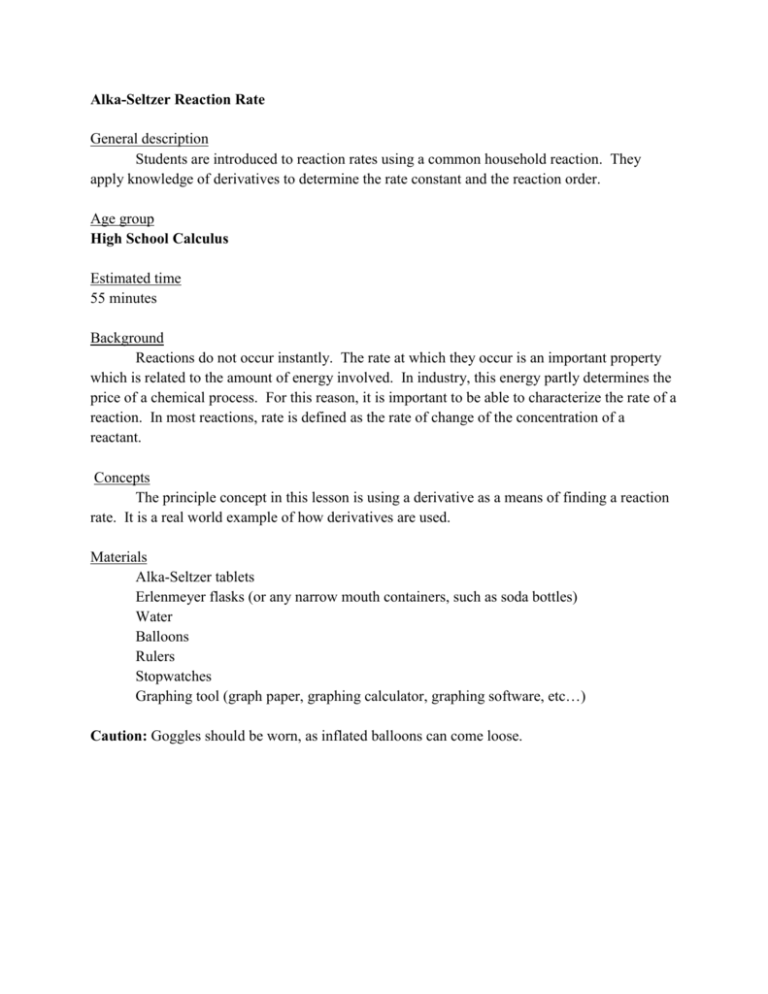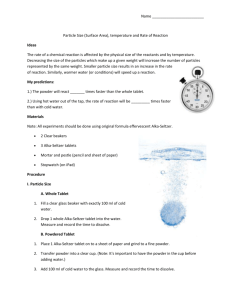reaction rate of Alka
advertisement

Alka-Seltzer Reaction Rate General description Students are introduced to reaction rates using a common household reaction. They apply knowledge of derivatives to determine the rate constant and the reaction order. Age group High School Calculus Estimated time 55 minutes Background Reactions do not occur instantly. The rate at which they occur is an important property which is related to the amount of energy involved. In industry, this energy partly determines the price of a chemical process. For this reason, it is important to be able to characterize the rate of a reaction. In most reactions, rate is defined as the rate of change of the concentration of a reactant. Concepts The principle concept in this lesson is using a derivative as a means of finding a reaction rate. It is a real world example of how derivatives are used. Materials Alka-Seltzer tablets Erlenmeyer flasks (or any narrow mouth containers, such as soda bottles) Water Balloons Rulers Stopwatches Graphing tool (graph paper, graphing calculator, graphing software, etc…) Caution: Goggles should be worn, as inflated balloons can come loose. Alka-Seltzer Reaction Rate Student Worksheet Chemical reactions don’t occur instantaneously. While many of the reactions we think of occur quickly, they still take time to proceed. In this exercise, we will attempt to measure the reaction rate of a reaction common in many households. Rate equations in chemistry are defined as 𝑑𝐶 𝑑𝑡 where r is the rate, C is the concentration of a reactant in moles per volume during the reaction, and t is time. These equations can typically be simplified for convenience, and by coincidence most reactions take the form 𝑑𝐶 𝑟=− = 𝑘𝐶 𝑛 𝑑𝑡 where k is called the rate constant, and n is called the reaction order. Both n and k can be determined by fitting the data to the equation. 𝑟=− When Alka-Seltzer is dropped into water, it begins to fizz. The bubbles formed are actually CO2. This reaction is nearly identical to that of baking soda and vinegar (acetic acid), since the reactive components of Alka-Seltzer are baking soda and citric acid. A basic method of data collection is given below to help with the calculation of the reaction rate of Alka-Seltzer in water. 1. 2. 3. 4. 5. 6. 7. 8. 9. Break a tablet of Alka-Seltzer in half and put it inside a balloon. Stretch the balloon over the Erlenmeyer flask filled with ~100 mL of water. Work the Alka-Seltzer from the balloon and into the water and begin timing immediately. Record the size (diameter, for example) of the balloon and the time at which you made the measurement. Record the size and time as many times as possible. When there is no significant change in the size of the balloon (after ~1.5 minutes) swirl the flask to finish dissolving any leftover Alka-Seltzer. When no bubbles are forming in the water, record the final size of the balloon. Determine the volume of the balloon at each point you recorded (you can assume the balloon to be a sphere). Plot the volume of the balloon versus time. Strictly speaking, we can’t use the volume of CO2 given off to find our reaction rate. We should consider the concentration of citric acid and baking soda in the tablet. To simplify this conversion, we will normalize the concentrations of all components. Divide all the volume measurements by the final volume, so now the data should range from 0 to 1. The normalized concentration of citric acid and baking soda in the tablet can then be determined by 𝐶𝑡𝑎𝑏𝑙𝑒𝑡 = 1 − 𝑁𝑜𝑟𝑚𝑎𝑙𝑖𝑧𝑒𝑑 𝑉𝑜𝑙𝑢𝑚𝑒 𝑜𝑓 𝐶𝑂2 For simplicity, the units of concentration of baking soda and citric acid in the tablet (Ctablet) will be “tablets of Alka-Seltzer” (for any overachievers in the group, you can find the actual concentration by multiplying this normalized concentration by the actual concentration found in one tablet of Alka-Seltzer, found on the tablet package, but this is unimportant for today). Plot Ctablet versus time. What shape does the curve take? Is it linear, parabolic, exponential, etc.? What does this plot represent? What does the slope of this plot represent? Fit the concentration curve to a function, then find the derivative of the function. This is the rate of reaction. To find the rate constant and reaction order, you can fit the rate of reaction to Ctablet. What reaction order did you determine? How do your results compare to other groups? Consider the following generic chemical reactions: AP (R1) A+BP+W (R2) A and B are the reactants available to purchase, and P is the desired product to sell. W is a byproduct which may or may not be marketable. The price of reactant A is $10 per mole, and B is $40 per mole. P can be sold for $100 per mole. Assume that W cannot be sold and is readily disposed of (price is $0). The company laboratory has determined that both reactions are zeroth order (n = 0), so the reaction rate expression simplifies to r=k If k for R1 is 1 mol/min and k for R2 is 2 mol/min, which reaction is more profitable for the chemical company? By how much? Alka-Seltzer Reaction Rate Answer Key Chemical reactions don’t occur instantaneously. While many of the reactions we think of occur quickly, they still take time to proceed. In this exercise, we will attempt to measure the reaction rate of a reaction common in many households. Rate equations in chemistry are defined as 𝑑𝐶 𝑑𝑡 where r is the rate, C is the concentration of a reactant in moles per volume during the reaction, and t is time. These equations can typically be simplified for convenience, and by coincidence most reactions take the form 𝑑𝐶 𝑟=− = 𝑘𝐶 𝑛 𝑑𝑡 where k is called the rate constant, and n is called the reaction order. Both n and k can be determined by fitting the data to the equation. 𝑟=− When Alka-Seltzer is dropped into water, it begins to fizz. The bubbles formed are actually CO2. This reaction is nearly identical to that of baking soda and vinegar (acetic acid), since the reactive components of Alka-Seltzer are baking soda and citric acid. A basic method of data collection is given below to help with the calculation of the reaction rate of Alka-Seltzer in water. 1. 2. 3. 4. 5. 6. 7. 8. 9. Break a tablet of Alka-Seltzer in half and put it inside a balloon. Stretch the balloon over the Erlenmeyer flask filled with ~100 mL of water. Work the Alka-Seltzer from the balloon and into the water and begin timing immediately. Record the size (diameter, for example) of the balloon and the time at which you made the measurement. Record the size and time as many times as possible. When there is no significant change in the size of the balloon (after ~1.5 minutes) swirl the flask to finish dissolving any leftover Alka-Seltzer. When no bubbles are forming in the water, record the final size of the balloon. Determine the volume of the balloon at each point you recorded (you can assume the balloon to be a sphere). Plot the volume of the balloon versus time. Strictly speaking, we can’t use the volume of CO2 given off to find our reaction rate. We should consider the concentration of citric acid and baking soda in the tablet. To simplify this conversion, we will normalize the concentrations of all components. Divide all the volume measurements by the final volume, so now the data should range from 0 to 1. The normalized concentration of citric acid and baking soda in the tablet can then be determined by 𝐶𝑡𝑎𝑏𝑙𝑒𝑡 = 1 − 𝑁𝑜𝑟𝑚𝑎𝑙𝑖𝑧𝑒𝑑 𝑉𝑜𝑙𝑢𝑚𝑒 𝑜𝑓 𝐶𝑂2 For simplicity, the units of concentration of baking soda and citric acid in the tablet (Ctablet) will be “tablets of Alka-Seltzer” (for any overachievers in the group, you can find the actual concentration by multiplying this normalized concentration by the actual concentration found in one tablet of Alka-Seltzer, found on the tablet package, but this is unimportant for today). Plot Ctablet versus time. What shape does the curve take? Is it linear, parabolic, exponential, etc…? Most will probably be nearly linear; some may be exponential decay. What does this plot represent? It demonstrates how much of the tablet has been used up at any given moment, or the “extent of the reaction.” What does the slope of this plot represent? It shows the reaction rate at any given time. Alternatively, it shows the reaction rate relative to how much of the tablet has been used up. Fit the concentration curve to a function, then find the derivative of the function. This is the rate of reaction. To find the rate constant and reaction order, you can fit the rate of reaction to Ctablet. What reaction order did you determine? If their plot above was linear, the reaction order should be 0, otherwise variable. How do your results compare to other groups? Most people’s results will be very different. This is due to experimental error, amount of water used, differences in tablets, etc… Consider the following generic chemical reactions: AP (R1) A+BP+W (R2) A and B are the reactants available to purchase, and P is the desired product to sell. W is a byproduct which may or may not be marketable. The price of reactant A is $10 per mole, and B is $40 per mole. P can be sold for $100 per mole. Assume that W cannot be sold and is readily disposed of (price is $0). The company laboratory has determined that both reactions are zeroth order (n = 0), so the reaction rate expression simplifies to r=k If k for R1 is 1 mol/min and k for R2 is 2 mol/min, which reaction is more profitable for the chemical company? By how much? For R1: (1 𝑚𝑜𝑙 𝑃 $ 𝑚𝑜𝑙 𝐴 $ $ ∗ 100 ) − (1 ∗ 10 ) = 90 𝑚𝑖𝑛 𝑚𝑜𝑙 𝑚𝑖𝑛 𝑚𝑖𝑛 𝑚𝑖𝑛 For R2: (2 𝑚𝑜𝑙 𝑃 $ 𝑚𝑜𝑙 𝐴 $ 𝑚𝑜𝑙 𝐵 $ $ ∗ 100 ) − (2 ∗ 10 ) − (2 ∗ 40 ) = 100 𝑚𝑖𝑛 𝑚𝑜𝑙 𝑚𝑖𝑛 𝑚𝑖𝑛 𝑚𝑖𝑛 𝑚𝑖𝑛 𝑚𝑖𝑛 R2 is more profitable by $10/min.






